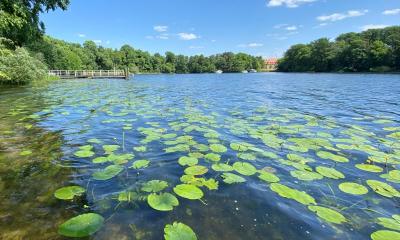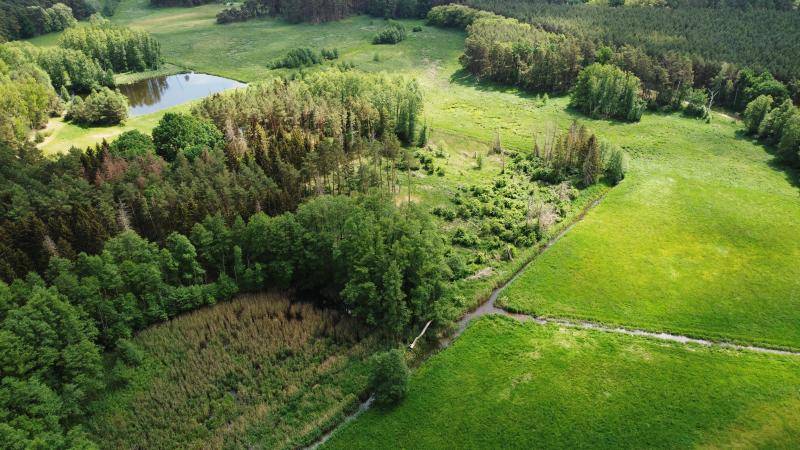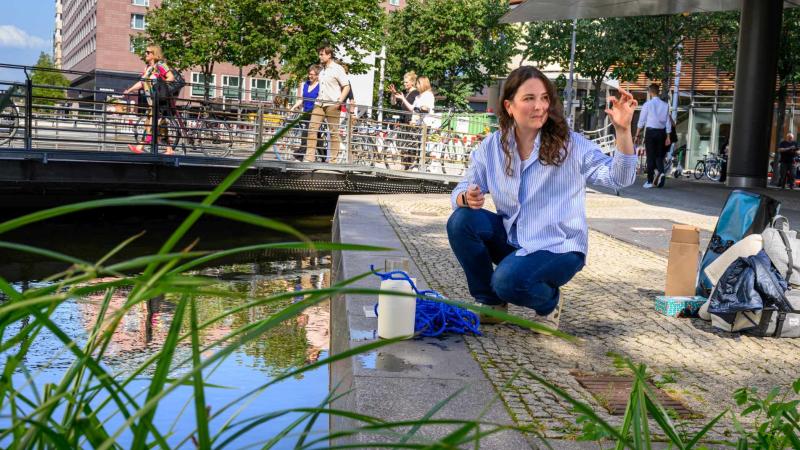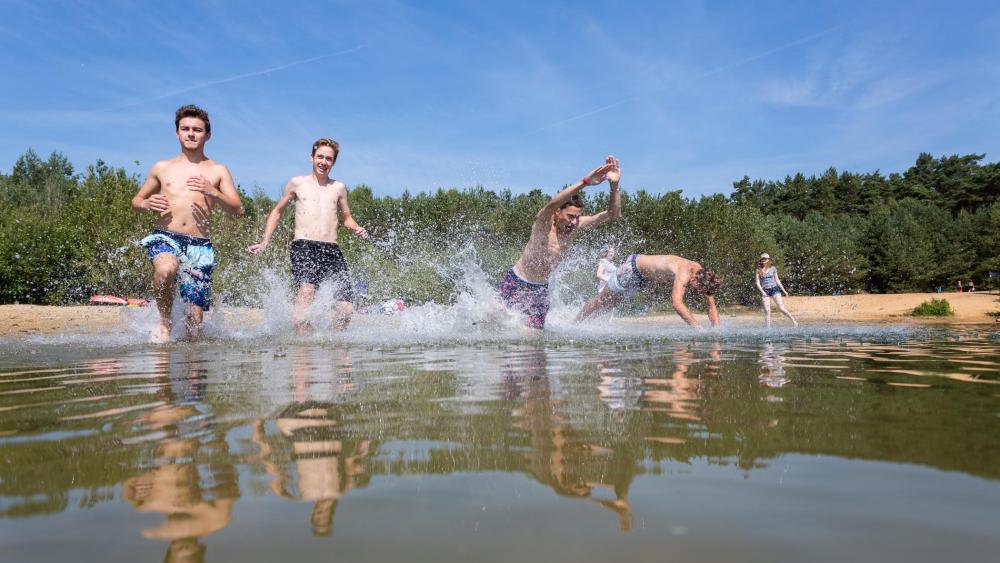
Wherever people swim and take a dip, plants and animals are often not far away – sometimes hidden, sometimes surprisingly close. If you have an unpleasant encounter in natural waters, it usually helps to leave the water and swim somewhere else. | Photo: Florian Möller

Perch. | Photo: Solvin Zankl
But this fish dares to come close to me!
Most fish are shy. However, some species that stay in shallow water and even swim where there are many bathers. Perch, for example, are one of such species. They are easily recognisable by their black stripes and reddish fins. Other species, such as roach and rudd, which also have reddish fins and silver-grey scales, dare to come quite close to our feet. In larger lakes, you can also observe swarms of bleak feeding on insects from the water's surface.
The notorious catfish, however, is rarely found where there are many bathers. It mainly stays at the bottom of lakes and rivers. Although it commands respect with its size, it is quite harmless to humans. In the summer months, however, catfish may appear near the shore. During the spawning season, the males in particular guard and defend their nests. They will attack anything that comes too close to their offspring, including swimmers' legs. The risk of injury is low though, as catfish have brush-like teeth rather than sharp ones. As a warm-water species, catfish thrive in higher temperatures. The climate crisis is therefore conducive to their spread: they spawn earlier, grow faster, and find good conditions in many bodies of water. Consequently, they are not an endangered species. In Germany, catfish measuring up to two metres in length are now commonly found, and in exceptional cases, up to 2.8 metres, particularly in large rivers.
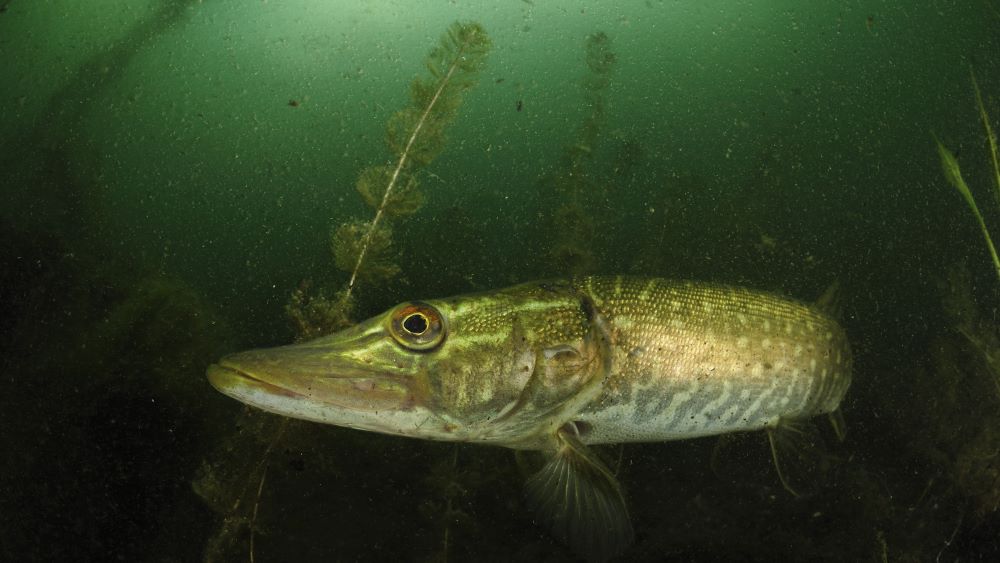
Pike. | Photo: Solvin Zankl
A fish with sharper teeth is the pike. It even has hundreds of them in its mouth. It is an ambush predator that often hides in reeds or water plants, shoots out at lightning speed and bites when a smaller fish swims past. But its prey can also include ducklings or swimming mice. In the media ‘summer slump’, there are often stories about supposedly giant pike. However, the largest pike are not usually found on the shore: in larger lakes, there are so-called open water pike that follow behind the schools of prey fish in deeper water and no longer stand in the aquatic plants near the shore. These pike can grow particularly large. However, pike do not defend their young or attack humans.

Grass snake. | Photo: TheOtherKEv auf Pixabay
Are there any water snakes in our region?
In principle, all snakes can swim. The most common snake found in water is the grass snake. This non-venomous species is the most common snake in Germany. It lives in and around stagnant waters, and is an excellent swimmer and diver. When swimming, it keeps its head above water.
Adders are also good swimmers. They are slightly venomous but not aggressive. Nevertheless, you should not catch or touch them. The dice snake is the rarest and most endangered snake species in Germany. Only a few animals of this species still exist on the banks of the Moselle, Nahe and Lahn rivers in the state of Rhineland-Palatinate. True sea snakes, which belong to the family of venomous snakes, are only found in the sea.

Beaver. | Photo: Shutterstock
Is it a beaver or a muskrat?
There's something with brown fur swimming in the water, and it's not a dog. It must be a beaver, right? It could also be a muskrat or a nutria. Muskrats are significantly smaller than beavers, while nutria can grow to almost the same size. You are more likely to encounter these two animals near water during the day than a beaver, which is active at dusk. The most striking difference is the tail: a beaver can be recognised by its flat, dark tail. The muskrat's tail is oval, while the nutria's is round. Another important distinguishing feature is that: When swimming, only the beaver's head sticks out of the water, whereas the muskrat or nutria has half of its body above the surface. Nutrias also have ears that clearly protrude from their fur, as well as white whiskers.
Neither animal is dangerous to humans as long as you leave them alone. However, if you get too close, they will defend themselves, and beavers in particular are very territorial. So, keep your distance. Incidentally, beavers have only returned to Germany in large numbers in recent years, after being almost exterminated. Their return is both celebrated and feared: as 'landscape architects', they create floodplains and valuable habitats for animal and plant species. However, their activities can also affect agriculture, fish farming, forestry, transport routes, and hydraulic engineering structures.

Water bug. | Photo: Solvin Zankl
There are also 'water bees'. However, these are not real bees, but backswimmers that belong to the water bug family. They can sting, which is why they are commonly known as 'water bees'.
But there are many more insects in the water. Around six per cent of all insect species worldwide spend at least one stage of their live cycle in water. Some flying insects, such as mayflies, stoneflies, caddisflies, dragonflies and mosquitoes, live as larvae in water. Therefore, a deterioration in water quality can also affect the occurrence of these species. Mayflies can spend over a year in the water before coming ashore for just a few days to mate. The water strider, on the other hand, lives at the interface between water and air. The tiny hairs on its legs enable it to move quickly across the surface of the water without sinking, thanks to surface tension. With a lot of luck, you may spot the silver spider, a species of water spider, while snorkelling. It is the only species of spider that lives underwater rather than on land. It collects air in a tightly woven underwater web that acts like a diving bell. The water spider is highly endangered because it needs particularly clean water to survive.

Quagga mussels. | Photo: Solvin Zankl
Ouch, I've cut my foot.
It must have been a mussel. In fact, more and more mussels have been found in our waters in recent years. Freshwater mussels are considered to be industrious cleaners of lakes and rivers. They filter small algae and suspended particles from the water, thus ensuring clear conditions. However, native species are under increasing pressure from invasive species such as the quagga mussel. This introduced species has a particularly large appetite; a single mussel can filter up to four litres of water per day, improving water quality and reducing the amount of cyanobacteria, but only at temperatures below 28°C. If the temperature rises above this, the mussels cease their activity and close their shells.
The influence of the quagga mussel extends far beyond water quality, however. It can extract so many nutrients from the ecosystem that fish can no longer find enough food. It also overgrows other mussels and molluscs, often severely restricting their movement and development.

Milfoil. | Photo: Michael Feierabend
Can you get caught in aquatic plants?
Water plants, also known as macrophytes, can either float on the water surface or take root at the bottom of a water body. They are useful because they help purify the water, produce oxygen, and provide food and shelter for many living creatures. Most water plants strive to reach the surface of the water because they need sunlight for photosynthesis. Therefore, water plants can be a nuisance when swimming and may seem scary to some people. However, most water plants, such as pondweed, hornwort and milfoil, can easily be brushed or torn off. Large stands of water plants, however, should be avoided as they may be overgrown with thread-like blue-green algae that produce toxins (see below). This happens at Lake Tegel in Berlin, for example.
Swimmers should also keep away from large water lily beds, because they are under nature conservation. And the real danger does not come from the plants, but from the panic they can cause in some people. You should therefore remain calm and ideally swim out of the water plants on your back just as you swam in. As a general rule, you should only swim where you feel comfortable and can assess the situation well.

Cyanobacteria. | Photo: Nadja Neumann
The water is covered with tiny green dots or streaks, which may have a bluish sheen.
These are most likely cyanobacteria, also known as blue-green algae. They used to be classified as algae because they can perform photosynthesis. However, unlike true algae, they do not have a cell nucleus and are therefore now classified as bacteria. The problem with cyanobacteria is that they can produce toxins that are harmful to animals and humans. However, this only occurs if they are ingested in large quantities.
To avoid any health risks, the relevant authorities regularly test bathing areas for cyanobacteria and their toxins. In serious cases, bathing areas are closed. As a general rule, if you can see your feet when you are standing in water up to your knees, it is safe to swim. If the water appears too green, it is advisable to swim elsewhere. Since cyanobacteria can irritate the skin, you should shower and change your swimwear immediately after swimming in such waters.

Benthic filamentous algae. | Photo: Sabine Hilt
There is cloudy algae on the shore and in the water.
These are probably benthic filamentous algae. This term is used to describe many different species of algae that have a similar appearance. Mass accumulations of benthic algae can endanger communities of organisms at the bottom of lakes and alter food webs, but the full range of possible effects is not yet known. The green algae carpets are not only unsightly for swimmers; they can also accumulate toxins from cyanobacteria. Dogs are attracted to the fishy smell of the algae and may ingest the toxins.
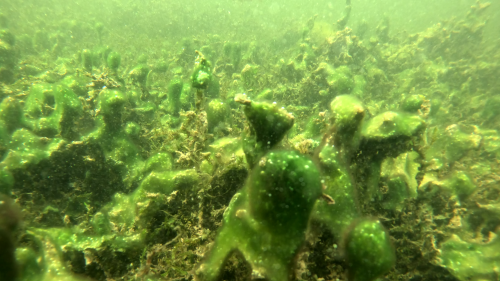
Slimy blobs at the bottom of Lake Tegel. | Photo: IGB
A relatively new phenomenon is the growth of so-called benthic cyanobacteria. These grow on larger underwater plants and fallen branches, or sometimes directly as slimy blobs on the bottom of the lake. Therefore, care should be taken on the lakeshore, especially after storms, as these slimy blobs can be washed ashore. If eaten by dogs or ingested with lake water, this can be very dangerous. Symptoms of poisoning can range from sudden death to apathy, tremors, and gastrointestinal problems. It is therefore better to keep dogs on a lead and check the shoreline yourself first. Keep also an eye on small children, who may put washed-up materials in their mouths while playing on the beach or in shallow water.
Why is the shore suddenly so far away?
Where there used to be water, there is now dry ground? Even lakes and other standing bodies of water are subject to natural fluctuations in water levels. At Lake Starnberg in Bavaria, for example, the water level varies by around half a metre over the course of the year. However, water levels have been conspicuously low in many regions of Germany in recent years, especially in the north-east. A study of 52 lakes by the IGB found that, in more than 70 per cent of cases, water levels fell between 1985 and 2022.
Such developments have consequences: falling water levels cause valuable riparian habitats for fish, amphibians and microorganisms to disappear. This was likely a decisive factor for the catfish in Lake Brombach: the low water level prevented the catfish from spawning in its usual areas, forcing the fish to seek refuge under a bathing island instead.
Lower water levels also alter the stratification and temperature conditions in lakes, influencing the oxygen and nutrient balance. When less water is available, nutrients and pollutants can accumulate more intensely in the remaining volume of water. In combination with higher temperatures, this promotes algae growth.
~
That was just a brief insight. There is much more to discover! You can find fascinating facts about freshwater bodies in our newsroom and in our IGB newsletter, which is published regularly.
Transparency note: Parts of this text were first published in July 2023. Following the recent attacks by a catfish, the text has been updated to include new IGB research content.





